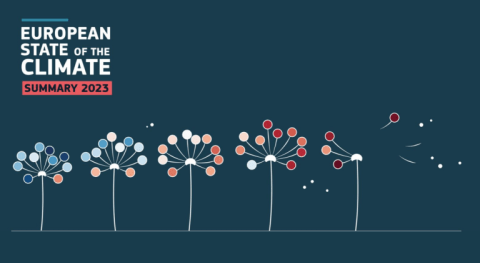Temperatures in Europe have increased at more than twice the global average over the past 30 years – the highest of any continent in the world. As the warming trend continues, exceptional heat, wildfires, floods and other climate change impacts will affect society, economies and ecosystems, according to a new report from the World Meteorological Organization (WMO).
The State of the Climate in Europe report, produced jointly with the European Union’s Copernicus Climate Change Service, focused on 2021. It provides information on rising temperatures, land and marine heatwaves, extreme weather, changing precipitation patterns and retreating ice and snow.
Temperatures over Europe have warmed significantly over the 1991-2021 period, at an average rate of about +0.5 °C per decade. As a result, Alpine glaciers lost 30 meters in ice thickness from 1997 to 2021. The Greenland ice sheet is melting and contributing to accelerating sea level rise. In summer 2021, Greenland saw a melt event and the first-ever recorded rainfall at its highest point, Summit station.

In 2021, high impact weather and climate events led to hundreds of fatalities, directly affected more than half a million people and caused economic damages exceeding US$ 50 billion. About 84% of the events were floods or storms.
It’s not all bad news. A number of countries in Europe have been very successful in cutting greenhouse gas emissions. In particular, in the European Union (EU) greenhouse gas emissions decreased 31% between 1990 and 2020, with a net 55% reduction target for 2030.
Europe is also one of the most advanced regions in cross-border cooperation in climate change adaptation, in particular across transnational river basins. It is one of the world leaders in providing effective early warning systems, with about 75% of people protected. Heat-health action plans have saved many lives from extreme heat.
But the challenges are formidable.
Temperatures in Europe have increased at more than twice the global average over the past 30 years
“Europe presents a live picture of a warming world and reminds us that even well prepared societies are not safe from impacts of extreme weather events. This year, like 2021, large parts of Europe have been affected by extensive heatwaves and drought, fuelling wildfires. In 2021, exceptional floods caused death and devastation,” said WMO Secretary-General Prof. Petteri Taalas.
“On the mitigation side, the good pace in reducing greenhouse gases emissions in the region should continue and ambition should be further increased. Europe can play a key role towards achieving a carbon neutral society by the middle of the century to meet the Paris Agreement,” said Prof. Taalas.
The EU’s Copernicus Climate Change Service (C3S), implemented by ECMWF on behalf of the European Commission, provides state-of-the-art climate monitoring data and tools to support climate mitigation and adaptation and initiatives such as the European Green Deal.
“European society is vulnerable to climate variability and change, but Europe is also at the forefront of the international effort to mitigate climate change and to develop innovative solutions to adapt to the new climate Europeans will have to live with,” said Dr. Carlo Buontempo, Director, Copernicus Climate Change Service, European Centre of Medium-range Weather Forecasts (ECMWF).
“As the risks and impact of climate change become increasingly apparent in day-to-day life, the need and the appetite grow for climate intelligence, and rightly so. With this report we aim to bridge the gap between the data and the analysis to provide science-based but accessible information that is ‘decision-ready’, across sectors, across professions,” he said.
The State of the Climate in Europe report builds on the C3S European State of the Climate published in April and information provided by the WMO RA VI Regional Climate Centre Network. It is one of a series of regional reports compiled by WMO in order to provide localized scientific information to policy makers. It was presented at a regional conference of directors of European national meteorological and hydrological services.
The report and an accompanying storymap includes input from national meteorological and hydrological services, climate experts, regional bodies and UN partner agencies. It was issued ahead of the annual UN Climate Change negotiations, COP27, in Sharm-El Sheikh.

Future Scenarios
Weather, climate and water-related disasters are projected to increase in the future, according to the Intergovernmental Panel on Climate Change Sixth Assessment Report (Working Group I, IPCC AR6 WGI). It assessed there was “high confidence” that:
- Regardless of future levels of global warming, temperatures will rise in all European areas at a rate exceeding global mean temperature changes, similar to past observations.
- The frequency and intensity of hot extremes, including marine heatwaves, have increased in recent decades and are projected to keep increasing regardless of the greenhouse gas emissions scenario. Critical thresholds relevant for ecosystems and humans are projected to be exceeded for global warming of 2 °C and higher.
- Observations have a seasonal and regional pattern consistent with projected increase of precipitation in winter in Northern Europe. A precipitation decrease is projected in summer in the Mediterranean extending to northward regions. Extreme precipitation and pluvial flooding are projected to increase at global warming levels exceeding 1.5°C in all regions except the Mediterranean.
Climate Impacts
Health: European people's health is impacted by climate change in a myriad of ways, including death and illness from increasingly frequent extreme weather events (heatwaves), increases in zoonoses and food-, water- and vector-borne diseases, and mental health issues.
The deadliest extreme climate events in Europe are heatwaves, particularly in western and in southern Europe. The combination of climate change, urbanization and population ageing in the region creates, and will further exacerbate, vulnerability to heat.
Climate change-induced alterations in the production and distribution of pollens and spores may lead to increases in allergic disorders. Over 24% of adults living in the European region suffer from various allergies, including severe asthma, while the proportion among children in the region is 30–40% and rising. Climate change also affects the distribution of vector-borne diseases. Examples include ticks (Ixodes ricinus), which can spread Lyme illness and tick-borne encephalitis.
According to WHO’s Regional Office for Europe, about half-million premature deaths in the WHO European Region were caused by anthropogenic fine particle ambient air pollution in 2019, of which an important part were directly linked to the burning of fossil fuels. It is estimated that about 138 000 premature deaths could be avoided per year through reduced carbon emissions, potentially resulting in savings of US$ 244–564 billion.
Children are more vulnerable to the impacts of climate change than adults, both physically and psychologically. According to the UNICEF Children’s Climate Risk Index (CCRI), nearly 125 million children in Europe live in countries with ‘medium to high’ risk countries (the third of five levels classification used globally).
Ecosystems: Most damage from wildfires is due to extreme events for which neither ecosystems nor communities are adapted. Climate change, human behaviours and other underlying factors are creating the conditions for more frequent, intense and devastating fires in Europe, with significant socioeconomic and ecological consequences.
Transport: Transport infrastructure and operations are at risk from both incremental climate change and extreme events (e.g. heat waves, heavy downpours, high winds and extreme sea levels and waves). Much transport infrastructure wase constructed based on historic values for various weather phenomena thresholds and so are not resilient to current extremes.
.png)
Climate Policy
Nationally determined contributions (NDCs) are at the heart of the Paris Agreement and the achievement of these long-term goals. NDCs embody efforts by each country to reduce national emissions and adapt to the impacts of climate change. As of March 2022, 51 European countries and the EU submitted an NDC.
Mitigation to climate change has been a primary focus for many European Parties, as reflected in their NDCs, highlighting the following priority areas: energy supply; agriculture; waste; and land use, land-use change and forestry as top priorities for mitigation.
In 2021, the European Union (EU) in its climate law made climate neutrality, the goal of zero net emissions by 2050, legally binding in the EU. It set an interim target of 55% emission reduction by 2030.


















